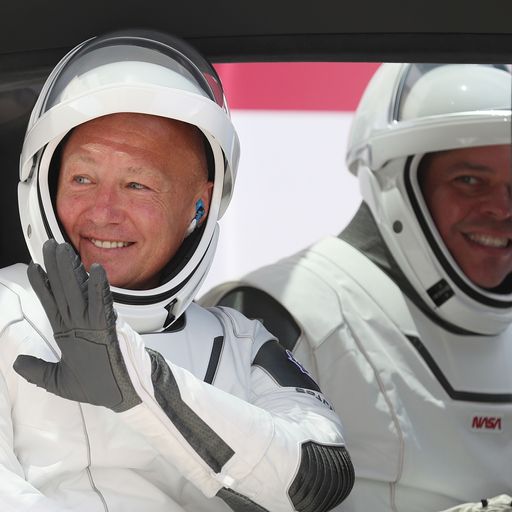NASA and SpaceX astronauts complete first splashdown to Earth in 45 years
The launch was the first manned mission for Elon Musk's SpaceX and the first private involvement in taking astronauts to the ISS.
Monday 3 August 2020 04:19, UK
NASA and SpaceX have successfully brought astronauts back from the International Space Station with the first ocean landing in 45 years.
Astronauts Douglas Hurley and Robert Behnken returned safely, splashing down in the Gulf of Mexico, 40 miles off Florida, early on Sunday evening.
Behnken called their trip "quite an odyssey", as Space X founder Elon Musk said he had prayed for a successful outcome.
The spacecraft went from 17,500mph (28,000kmh) in orbit to 350mph (560kmh) during re-entry, and finally to 15mph (24kmh) as it parachuted into the water.
It was exposed to a peak temperature of 1,900C (3,500F) during the descent.
The historic mission began in May when NASA completed the first space launch from US soil for almost a decade, thanks to SpaceX's Falcon 9 rocket.
The landing could have been complicated by private boats which ignored restrictions and ventured close to the splashdown zone, one of which was flying a Trump campaign flag.
"Welcome back to planet Earth and thanks for flying SpaceX," said controllers at SpaceX headquarters.
"It was truly our honour and privilege," replied Hurley.
The astronauts gave the thumbs up as a crane hauled the craft on to a recovery ship.
After medical checks by a crew who had been in strict quarantine, they were flown by helicopter to Pensacola, then to Houston.
"This has been quite an odyssey," Hurley said at a homecoming ceremony at Johnson Space Center.
"To be where we are now, the first crewed flight of Dragon, is just unbelievable."
He added: "It's a little bit overwhelming to see everybody here considering the things that have gone on the last few months since we've been off planet."
The astronauts were greeted by a small group of mask-wearing family and officials - including an emotional Elon Musk - who declared: "This day heralds a new age of space exploration. I'm not very religious, but I prayed for this one."
The billionaire entrepreneur later tweeted: "When space travel becomes as common as air travel, the future of civilization will be assured."
President Trump also praised the mission, posting: "Great to have NASA Astronauts return to Earth after very successful two month mission. Thank you to all!"
He had flown to Florida for the May lift-off, making him the first president to watch one since Bill Clinton.
The launch, named Demo-2, was the first manned mission for Musk's spaceflight company SpaceX - and the first private involvement in taking astronauts to the ISS.
NASA will now fully certify the company to conduct manned launches in the future.
The next of these will feature Behnken's wife, Megan McArthur - an oceanographer and NASA astronaut who has previously flown one space shuttle mission.
America hasn't had the ability to launch astronauts from its own soil since 8 July 2011, when the Space Shuttle programme was retired.
NASA had been relying on Soyuz spacecraft, operated by Russia's space agency Roscosmos, to ferry its astronauts to the ISS.
Russian space launches aren't cheap - for astronauts travelling to the ISS using Soyuz rockets from the Baikonur Cosmodrome in Kazakhstan, it costs up to $86m (£70m) per seat.
NASA launched its Commercial Crew Program in 2010, to find private sector partners who could launch astronauts safely to the ISS, although funding issues delayed the initial launches.
Now SpaceX is offering to return this capability to American soil, charging just $55m (£45m) per seat.
Boeing is also bidding to contribute, although its seat costs have varied - according to different estimates between $70m (£57m) and $90m (£74m) - potentially making it more expensive than a Soyuz launch.
Boeing's test flight is scheduled for 20 December.







Comments
Post a Comment